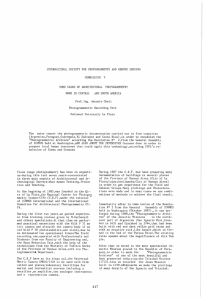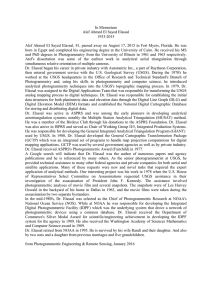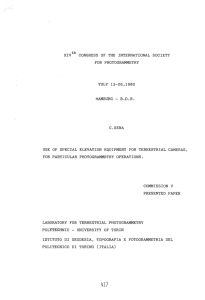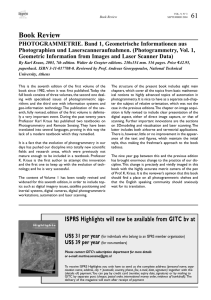International Archives of Photogrammetry, Remote Sensing and Spatial Information Sciences,...
advertisement
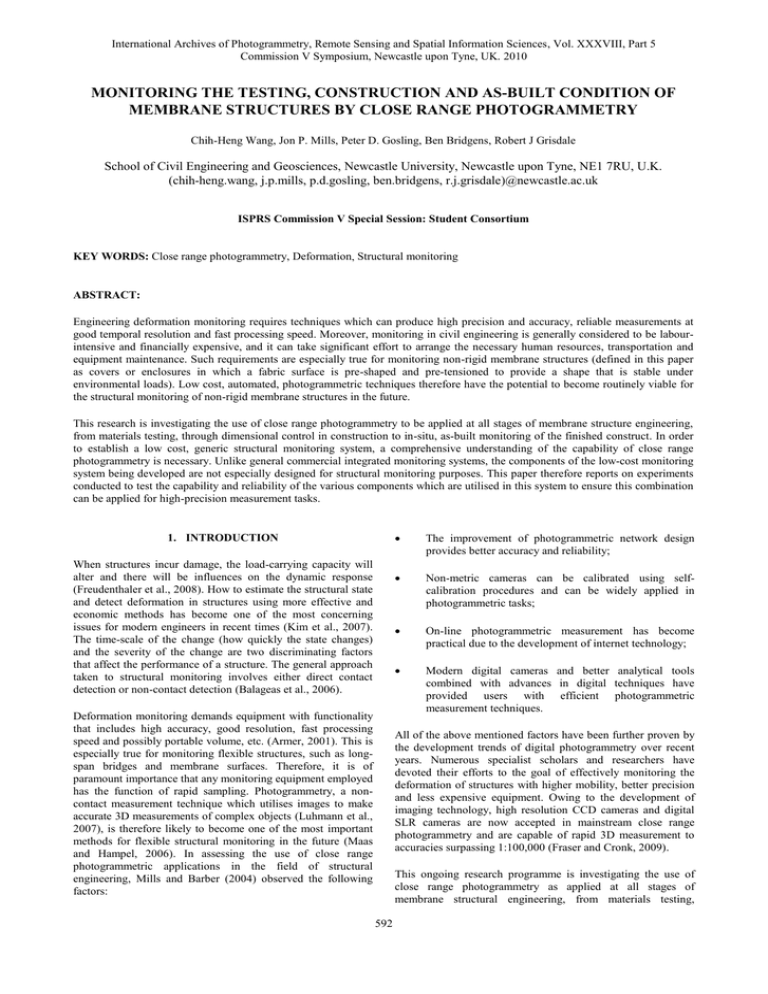
International Archives of Photogrammetry, Remote Sensing and Spatial Information Sciences, Vol. XXXVIII, Part 5 Commission V Symposium, Newcastle upon Tyne, UK. 2010 MONITORING THE TESTING, CONSTRUCTION AND AS-BUILT CONDITION OF MEMBRANE STRUCTURES BY CLOSE RANGE PHOTOGRAMMETRY Chih-Heng Wang, Jon P. Mills, Peter D. Gosling, Ben Bridgens, Robert J Grisdale School of Civil Engineering and Geosciences, Newcastle University, Newcastle upon Tyne, NE1 7RU, U.K. (chih-heng.wang, j.p.mills, p.d.gosling, ben.bridgens, r.j.grisdale)@newcastle.ac.uk ISPRS Commission V Special Session: Student Consortium KEY WORDS: Close range photogrammetry, Deformation, Structural monitoring ABSTRACT: Engineering deformation monitoring requires techniques which can produce high precision and accuracy, reliable measurements at good temporal resolution and fast processing speed. Moreover, monitoring in civil engineering is generally considered to be labourintensive and financially expensive, and it can take significant effort to arrange the necessary human resources, transportation and equipment maintenance. Such requirements are especially true for monitoring non-rigid membrane structures (defined in this paper as covers or enclosures in which a fabric surface is pre-shaped and pre-tensioned to provide a shape that is stable under environmental loads). Low cost, automated, photogrammetric techniques therefore have the potential to become routinely viable for the structural monitoring of non-rigid membrane structures in the future. This research is investigating the use of close range photogrammetry to be applied at all stages of membrane structure engineering, from materials testing, through dimensional control in construction to in-situ, as-built monitoring of the finished construct. In order to establish a low cost, generic structural monitoring system, a comprehensive understanding of the capability of close range photogrammetry is necessary. Unlike general commercial integrated monitoring systems, the components of the low-cost monitoring system being developed are not especially designed for structural monitoring purposes. This paper therefore reports on experiments conducted to test the capability and reliability of the various components which are utilised in this system to ensure this combination can be applied for high-precision measurement tasks. 1. INTRODUCTION When structures incur damage, the load-carrying capacity will alter and there will be influences on the dynamic response (Freudenthaler et al., 2008). How to estimate the structural state and detect deformation in structures using more effective and economic methods has become one of the most concerning issues for modern engineers in recent times (Kim et al., 2007). The time-scale of the change (how quickly the state changes) and the severity of the change are two discriminating factors that affect the performance of a structure. The general approach taken to structural monitoring involves either direct contact detection or non-contact detection (Balageas et al., 2006). Deformation monitoring demands equipment with functionality that includes high accuracy, good resolution, fast processing speed and possibly portable volume, etc. (Armer, 2001). This is especially true for monitoring flexible structures, such as longspan bridges and membrane surfaces. Therefore, it is of paramount importance that any monitoring equipment employed has the function of rapid sampling. Photogrammetry, a noncontact measurement technique which utilises images to make accurate 3D measurements of complex objects (Luhmann et al., 2007), is therefore likely to become one of the most important methods for flexible structural monitoring in the future (Maas and Hampel, 2006). In assessing the use of close range photogrammetric applications in the field of structural engineering, Mills and Barber (2004) observed the following factors: The improvement of photogrammetric network design provides better accuracy and reliability; Non-metric cameras can be calibrated using selfcalibration procedures and can be widely applied in photogrammetric tasks; On-line photogrammetric measurement has become practical due to the development of internet technology; Modern digital cameras and better analytical tools combined with advances in digital techniques have provided users with efficient photogrammetric measurement techniques. All of the above mentioned factors have been further proven by the development trends of digital photogrammetry over recent years. Numerous specialist scholars and researchers have devoted their efforts to the goal of effectively monitoring the deformation of structures with higher mobility, better precision and less expensive equipment. Owing to the development of imaging technology, high resolution CCD cameras and digital SLR cameras are now accepted in mainstream close range photogrammetry and are capable of rapid 3D measurement to accuracies surpassing 1:100,000 (Fraser and Cronk, 2009). This ongoing research programme is investigating the use of close range photogrammetry as applied at all stages of membrane structural engineering, from materials testing, 592 International Archives of Photogrammetry, Remote Sensing and Spatial Information Sciences, Vol. XXXVIII, Part 5 Commission V Symposium, Newcastle upon Tyne, UK. 2010 through dimensional control in construction to in-situ, as-built monitoring of the finished construct. It is anticipated that by combining low cost imaging devices with contemporary communication technologies, a low cost, ubiquitous, in-situ structural monitoring system with the capability to conduct unsupervised, on-site, long-term remote monitoring of membrane structures is feasible. This paper reports findings from initial laboratory experiments that are investigating the stability, reliability and limitations of each item of software and equipment that are to be utilised in the monitoring solution. The paper first describes the laboratory testing procedures, including test material samples, hardware and software, then describes the measurement methodology. The results section provides information regarding the performance of each component and the paper concludes with a brief discussion as to how the findings impact the design of the low cost photogrammetric monitoring system in the next stage of the research. measured using a single stage plate of a Zeiss P3 analytical plotter. 2. LABORATORY TESTING The Vision Metrology System (VMS) software was another photogrammetric processing package used in this research. It was written in the Visual C++ language and is based on the colinearity equations and iterative least squares estimation. Its primary function is calculating 3D object space coordinates from 2D images. The optimal accuracy is 1:120,000 (Johnson et al., 2004). The VMS software was used in these experiments to validate the PhotoModeler software. 2.1 Characteristics of test material photogrammetric target generation samples 2.3 Experimental software The processing photogrammetric software used in this research was PhotoModeler Scanner Version 6 (hereinafter referred to as PhotoModeler). This is commercial, off-the-shelf software. According to the user manual, PhotoModeler claims the accuracy can be achieved 1: 28,000 (PhotoModeler, 2010). It is also relatively inexpensive compared to most other commercial photogrammetric software; for example, it costs approximately 15 times less than the V-STARS software, which does however claim a superior accuracy of up to 1:160,000 (V-STARS, 2010). Given its relatively low cost and friendly graphical user interface (GUI), PhotoModeler has become a popular choice for reverse engineering and many other engineering applications (Young and Garde, 2007). and The membrane test material investigated in this preliminary research was PVC (Polyvinyl chloride). With the characteristics of fast construction speed and durability, PVC fabrics are extensively adopted in membrane structure constructions such as canopy and roof materials (Lin et al., 2008). For testing purposes, the test fabric samples were cut into 300 mm squares. Because the fabric surface is white and glossy, some form of targeting is necessary on the object to facilitate precise photogrammetric measurement. Unfortunately, the fabric was too thick to be passed through a generic computer printer that would have enabled the direct transfer of targets from CAD onto the test material’s surface (in addition to which, the heat/pressure of computer printing could have adverse affects on the material’s properties). An alternative approach was developed whereby the CAD target pattern was transferred onto a template that was cut using a vinyl cutter. The template was then stuck onto the test fabric and an oil-based paint spread across it using a palette knife. In this manner, one hundred circular targets, each of 4 mm diameter, were printed across the centre of each 300 x 300 mm fabric test sheet in a 20 mm spaced grid pattern. 3. METHODOLOGY 3.1 Camera calibration and software validation Until calibration is completed, a non-metric camera cannot generally be used for photogrammetric measurement (Habib and Morgan, 2005). Remondino and Fraser (2006) provided a brief description of the classification of camera calibration, summarized as follows. The calibration software which was chosen in this research was based on the bundle adjustment principle. During the process of self-calibration, all the intrinsic parameters of the camera are calculated from the information in the images taken by the camera. The only requirement is that there has to be a static object in the scene, and the camera would rotate around the object taking images. The movement of the camera does not need to be known (Mendonca and Cipolla, 1999). 2.2 Experimental hardware In laboratory testing, the 300 x 300 mm fabric test sheets will be stretched by a two axis stretch pallet (the pallet is able to handle an object with dimensions of one meter square). In order to estimate the consistency and stability of the proposed photogrammetric system, experiments to examine the effectiveness of the photogrammetric procedures were necessary. The 300 x 300 mm fabric test sheets were substituted by a similar sized glass plate with the same target pattern transferred onto it, and two types of image acquisition device (video cameras and DSLR cameras) were assessed. For this purpose, a video camera (AVT Oscar F-810C / 8-megapixel with a 12mm f1.4 lens) and a DSLR camera (Nikon D300 / 13.1-megapixel with a Nikon AF 28mm f2.8D lens) were used to image the stable glass plate under laboratory conditions. The data collected using the video and DSLR cameras were subsequently statistically compared, both against each other and with data 593 The F-810C video and D300 cameras were calibrated using both PhotoModeler and VMS. Two sets of camera parameters were therefore computed following this process. The cameras were then used to measure the same simple test field. The illustration of the simple test field setup is shown in Figure 1, where nine targets printed on an 85 mm square target plate were hung on a solid wall. Both an F-810C video camera and a D300 camera were setup 650 mm away from the test sheet and images taken from three different camera stations (positions 1, 2 and 3) with slightly convergent imagery. The temperature of the indoor test field was controlled at 15 1 degrees Celsius and the relative humidity was 32%. The Image capture process was undertaken in stable environmental conditions in order to minimize the effects of any climatic changes on measurement performance. International Archives of Photogrammetry, Remote Sensing and Spatial Information Sciences, Vol. XXXVIII, Part 5 Commission V Symposium, Newcastle upon Tyne, UK. 2010 Both the video and DSLR cameras were used to capture 10 sets of images in position 1, 2, and 3. Each data set includes three images which were captured from three different camera stations. These data were each subsequently run through the photogrammetric process using both PhotoModeler and VMS. By comparing these photogrammetric results, the relative performance of PhotoModeler could be evaluated against that of VMS. coordinates from Photomodeler were exported to dxf file format, then edited and transformed into a txt file. Although the PhotoModeler computation process is automatic, some tasks, for example data sorting and control point re-selection, still rely on manual intervention. Reducing the amount of this intervention is therefore one of the most critical tasks in the future establishment of a fully automated system. 3.4 Validation of photogrammetric measurements In considering the complete system performance, simply drawing conclusions from comparison to other similar systems is not particularly satisfactory. Therefore, a physical measurement was designed as a contrast benchmark. The two dimensional coordinates of the glass test plate were obtained through manual measurements conducted using a Zeiss P3 analytical plotter. The P3 is a photogrammetric plotting instrument with a measurement system resolution of 1 μm. Although only two dimensional coordinates were observed (with the object measured on a single stage plate of the P3), data measured in this way provided “truth” values of known quality (a precision test, explained below, was performed) for comparison against the PhotoModeler derived data. Coordinates of all 100 targets were measured three times in the P3 and averaged in order to improve measurement precision. 3.5 Data comparison and analysis Each camera system was used to provide five independent sets of data (i.e. each network was independently captured and processed five times) and each set of data contains 100 target coordinates. The photogrammetric results were processed using the PhotoModeler software package. As the measurement of primary interest to structural engineers is strain (as opposed to object coordinates), these 100 points can be used to obtain 90 distances in the horizontal and vertical axes, respectively. The data from horizontal and vertical directions were separated into two different groups for ease of comparison. The distances between adjacent points could then be compared with the P3 measurements and the quality of each set of results estimated. Figure 1. A simple test field to check the consistency of PhotoModeler against VMS software. 3.2 Image acquisition process Although the fundamental requirement for the generation of three dimensional measurements is a stereopair, the minimum practical requirement for processing within photomodeler is imagery taken from three camera stations. However, subject to budget constraints, multiple sets of images could be taken from different perspectives in order to strengthen the photogrammetric network and improve overall measurement performance. Therefore in testing, multiple images were taken of the stable glass plate from different numbers of camera stations in order to simulate the use of multiple cameras during stretch pallet testing. 4. RESULTS 4.1 Comparison of PhotoModeler with VMS When undertaking stretch pallet testing in practice it is the intention to control camera shutters by synchronous software to ensure images are captured simultaneously. As a result, the signal delay will be limited to 5 milliseconds between stations. Images will be transferred into storage at the same time via a USB relay for further processing. However in pre-testing this was achieved by rotating the stable glass plate in front of a single static camera. In the results presented herein, images were captured using an F-810C video camera and a D300 camera from each side of the square test plate (i.e. four convergent images). The data capture and subsequent photogrammetric processing procedures were independently repeated five times. A simple laboratory test field was established to examine the applicability of PhotoModeler in comparison to the VMS software (Figure 1). There were nine points on the test field, and the horizontal distances between adjacent points were computed by PhotoModeler and VMS separately. The differences between the two utilised software packages are given in Table 1. The values presented are the mean result of 10 data sets processed using each system. According to the distribution of target points, these six distance observations can be divided into three rows. The top row was formed by the section from point 1 to 2 (S1~2) and the section from point 2 to 3 (S2~3). The middle row was formed by S4~5 and S5~6. Then, the bottom row was formed by S7~8 and S8~9. The differences of top row which were computed from D300 camera’s images are 96 μm and 75 μm respectively. The results in middle row were negative. Coming to the bottom row, the differences in S7~8 and S8~9 rose up again to 75 μm and 3.3 Image processing Images were captured and stored following a specific sequence. The image measurements and bundle adjustment were executed using the PhotoModeler Scanner software. Photogrammetric 594 International Archives of Photogrammetry, Remote Sensing and Spatial Information Sciences, Vol. XXXVIII, Part 5 Commission V Symposium, Newcastle upon Tyne, UK. 2010 94 μm. The trend was similar when computed from the F810 video camera’s images. Camera calibration and/or the use of a network that can be considered non-optimal may be playing a part in this apparent systematic effect. Cam Distance Mean PM (mm) Mean VMS D300 (mm) Difference (mm) Mean PM (mm) Mean VMS F810 (mm) Difference (mm) S1~2 S2~3 S4~5 S5~6 S7~8 Tables 3 and 4 (the average of five sets of observations). Results are presented for horizontal and vertical distances by sensor type. Focusing on the standard deviation values, results for images captured by the D300 DSLR were 19 and 17 μm in horizontal and vertical directions respectively. The standard deviation values were very slightly better for the F810 video camera data, being 16 μm in both vertical and horizontal direction. Root mean square errors (RMSe) values had the opposite trend; the F810 video camera’s data were 1 μm higher than the DSLR in two groups. Combined with the mean result for each sensor, this is indicative of some small systematic bias in the F810 measurements. Nevertheless, the statistics of these two systems are very similar in both horizontal and vertical directions and none of these differences can be considered significant, indicating that both sensors are operating to a similar level of performance. S8~9 39.976 40.139 39.965 40.132 40.226 39.969 40.072 40,214 39.987 40.097 40.301 40.063 0.096 0.075 -0.022 -0.035 0.075 0.094 40.076 39.997 40.017 40.132 40.181 40.067 40.172 40.074 39.954 40.097 40.098 40.128 0.096 0.077 -0.063 -0.035 -0.083 0.061 Horizontal Diff._D300 (μm) Diff._F810 (μm) difference (μm) Mean 2 12 -10 Maximum 70 54 16 Minimum -32 -26 -6 Range 102 80 22 SD 19 16 3 RMSe 19 20 -1 Table 1. Comparison of PhotoModeler (PM) and VMS software. 4.2 Stability of Zeiss P3 analytical plotter As a control, the P3 measurements underwent a strict inspection before they were used as a benchmark for comparison. Three points on the test plate were chosen as observation targets. These were located in the top right, middle and lower left of the glass plate. Each target had a 0.1 mm diameter white spot in the centre to facilitate manual placement of the P3’s 72 μm measuring mark. Each point was manually measured 50 times and the standard deviation of each measurement set calculated. These results were used to analyse the degree of dispersion of the observation data. Table 3. Statistics of the horizontal distance observations. Vertical Diff._d300 (μm) Diff._F810 (μm) Difference (μm) Mean 0 8 -8 Maximum 48 51 -3 Minimum -35 -41 -6 Pt x (μm) y (μm) SD_1 5.4 4.9 Range 83 92 -9 SD_2 6.7 5.7 SD 17 16 1 SD_3 5.2 5.0 RMSe 17 18 -1 Mean 5.8 5.2 Table 4. Statistics of the vertical distance observations. Table 2. Standard deviation of three targets each measured 50 times in a Zeiss P3. 5. DISCUSSION The results of Table 3 and Table 4 indicate that, provided image stations are arranged following strict geometric configuration and the camera calibration process was executed thoroughly, off-the-shelf cameras and low cost software can be effectively utilized in such a photogrammetric task. Through mounting cameras on more stable platforms and running the experiment in a temperature controlled testing laboratory, it should be possible to push the accuracy to a higher level. Comparing with traditional measurements, this method is significantly cheaper than utilizing laser scanners for monitoring, and more time efficient than measuring targets by other sensors. This is not even considering the benefits of labour-saving and instrument portability that such a measurement approach can provide. Table 2 shown above gives the standard deviations of measurements for each point. The x and y coordinates of point 1(the top right point) are 5.4 μm and 4.9 μm respectively. Values of the central point are 6.7 μm and 5.7 μm. The values of lower left point are 5.2 μm and 5.0 μm. The mean results of 5.8 μm and 5.2 μm give an indication of the practical x, y measurement precision of the targets in the plotter. To improve precision further, each of the 100 targets on the test field were measured using the P3 three times. 4.3 Comparison of photogrammetric results and physical measurements The PhotoModeler photogrammetric results were compared with the P3 measurements, the results of which are presented in 595 International Archives of Photogrammetry, Remote Sensing and Spatial Information Sciences, Vol. XXXVIII, Part 5 Commission V Symposium, Newcastle upon Tyne, UK. 2010 The foundation work for this research programme, which examines the capability of experimental hardware and software has been completed. The adjustment of geometric distribution of cameras or using higher resolution images may be able to enhance the contrast and lead to better image processing results (Akca and Gruen, 2009). Photogrammetric Engineering & Remote Sensing, 71( 9): 733741. For long term monitoring purposes, an automatic workflow is the goal engineers and specialists pursue. Large quantities of imagery are accumulated when processing long monitoring tasks. During the period of processing the experimental data, more than 50 percent of time was used in filing and data sorting. 6. CONCLUSIONS AND FUTURE WORK In this investigation, an inspection into the stability and reliability of image acquisition devices and processing software for flexible structural monitoring has been undertaken using cross-comparison. Due to the processing software (PhotoModeler) being of commercial origin, the accuracy assessment was independently validated using the Vision Metrology System (VMS) software. The provisional results presented herein indicate that PhotoModeler consistently returns distance observations to within 0.1 mm of those from VMS. The assessment of the stability of digital image acquisition system has also been completed. The RMSe values show consistent results for two different image capture devices. These results allow the research to move forward to the next stage, which is to focus on dynamic testing of flexible materials in a laboratory test environment. The capability of this system for dynamic monitoring will be comprehensively inspected. The system will subsequently be set outdoors for real-world experiments to prove the capability of this photogrammetric solution for structural monitoring. Johnson, G. W., Laskey, S. E., Robson, S. and Shortis, M. R., 2004. Dimensional and accuracy control automation in shipbuilding fabrication: an integration of advanced image interpretation, analysis and visualization techniques. International Archives of the Photogrammetry, Remote Sensing and Spatial Information Sciences, 35(5): 984-989. Kim, S., Pakzad, S., Culler, D., Demmel, J., Fenves, G., Glaser, S., Turon, M., 2006. Health monitoring of civil Infrastructures using wireless. sensor networks. In: Proceedings of the 4th international Conference on Embedded Networked Sensor Systems, New York, USA: 254-263. Lin, S.-Y. and Mills, J. P., 2006. A non-contact monitoring system for investigating as-built membrane roof structures. International Archives of the Photogrammetry, Remote Sensing and Spatial Information Sciences, 36 (A5): 161–166. Lin, S.-Y., Mills, J. P. and GOSLING, P. D., 2008. Videogrammetric monitoring of as-built membrane roof structures. Photogrammetric Record, 23(122): 128-147. Luhmann, T., Robson, S., Kyle, S. and Harley, I., 2007. Close range photogrammetry: principles, techniques and applications. John Wiley & Sons, pp. 57. Maas, H.-G. and Hampel, U., 2006. Photogrammetric techniques in civil engineering material testing and structure monitoring. Photogrammetric Engineering & Remote Sensing, 72(1): 39-46. REFERENCES Mendonca, P. and Cipolla, R., 1999. A simple technique for self-calibration. In: Proc. IEEE Conf. on Computer Vision and Pattern Recognition, 1(CVPR99): 500-505. Akca, D. and Gruen, A., 2009. Comparative geometric and radiometric evaluation of mobile phone and still video cameras. Photogrammetric Record, 24(127): 217-245. Mills, J. P. and Barber, D., 2004. Geomatics Techniques for Structural Surveying. Journal of Surveying Engineering, 130(2): 56-64. Armer, G., 2001. Monitoring and assessment of structures. Taylor and Francis, pp. 105. PhotoModeler, 2010. http://www.photomodeler.com/products /photomodeler/articles_and_reports.htm (accessed: 17th April 2010). Balageas, D., Fritzen, C. P. and Gueemes, A., 2006. Structural health monitoring. Wiley-ISTE, pp. 286. V-STARS Photogrammetry-Systems, http://www.gdvsystems.com/index.php?ID=10012 (accessed: 28th April 2010). Remondino, F. and Fraser, C., 2006. Digital camera calibration methods: considerations and comparisons. International Archives of the Photogrammetry, Remote Sensing and Spatial Information Sciences, 36(A5): 266-272. Fraser, C. S. and Cronk, S., 2009. A hybrid measurement approach for close-range photogrammetry. International Archives of the Photogrammetry, Remote Sensing and Spatial Information Sciences, 64(3): 328-333. Young, L. and Garde, G., 2007. A practical approach for scientific balloon film strain measurement using photogrammetry. AIAA Balloon Systems Conference, Williamsburg, USA: 11-17. Freudenthaler, B., Gutenbrunner, G., Stumptner, R. and Küng, J., 2008. Case-based decision support for bridge monitoring. In: The Third International Multi-Conference on Computing in the Global Information Technology, Athens. 31 - 36. Habib, A. and Morgan, M., 2005. Stability analysis and geometric calibration of off-the-shelf digital cameras. 596



